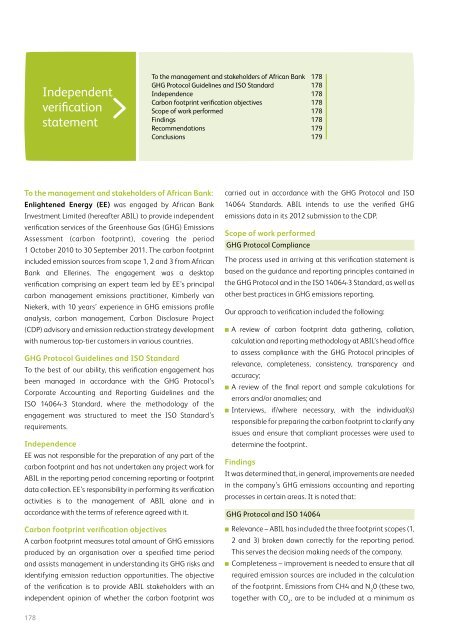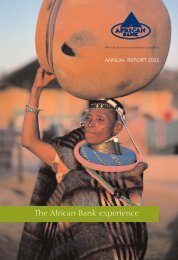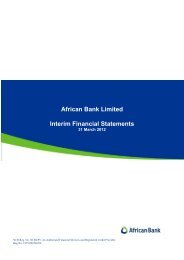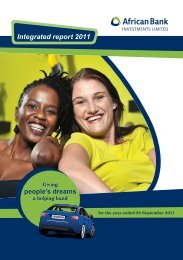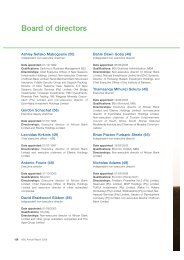Full annual report - African Bank - Investoreports
Full annual report - African Bank - Investoreports
Full annual report - African Bank - Investoreports
You also want an ePaper? Increase the reach of your titles
YUMPU automatically turns print PDFs into web optimized ePapers that Google loves.
To the management and stakeholders of <strong>African</strong> <strong>Bank</strong>:<br />
Enlightened Energy (EE) was engaged by <strong>African</strong> <strong>Bank</strong><br />
Investment Limited (hereafter ABIL) to provide independent<br />
verification services of the Greenhouse Gas (GHG) Emissions<br />
Assessment (carbon footprint), covering the period<br />
1 October 2010 to 30 September 2011. The carbon footprint<br />
included emission sources from scope 1, 2 and 3 from <strong>African</strong><br />
<strong>Bank</strong> and Ellerines. The engagement was a desktop<br />
verification comprising an expert team led by EE’s principal<br />
carbon management emissions practitioner, Kimberly van<br />
Niekerk, with 10 years’ experience in GHG emissions profile<br />
analysis, carbon management, Carbon Disclosure Project<br />
(CDP) advisory and emission reduction strategy development<br />
with numerous top-tier customers in various countries.<br />
GHG Protocol Guidelines and ISO Standard<br />
To the best of our ability, this verification engagement has<br />
been managed in accordance with the GHG Protocol’s<br />
Corporate Accounting and Reporting Guidelines and the<br />
ISO 14064-3 Standard, where the methodology of the<br />
engagement was structured to meet the ISO Standard’s<br />
requirements.<br />
Independence<br />
EE was not responsible for the preparation of any part of the<br />
carbon footprint and has not undertaken any project work for<br />
ABIL in the <strong>report</strong>ing period concerning <strong>report</strong>ing or footprint<br />
data collection. EE’s responsibility in performing its verification<br />
activities is to the management of ABIL alone and in<br />
accordance with the terms of reference agreed with it.<br />
Carbon footprint verification objectives<br />
A carbon footprint measures total amount of GHG emissions<br />
produced by an organisation over a specified time period<br />
and assists management in understanding its GHG risks and<br />
identifying emission reduction opportunities. The objective<br />
of the verification is to provide ABIL stakeholders with an<br />
independent opinion of whether the carbon footprint was<br />
178<br />
Independent<br />
verification<br />
statement<br />
To the management and stakeholders of <strong>African</strong> <strong>Bank</strong> 178<br />
GHG Protocol Guidelines and ISO Standard 178<br />
Independence 178<br />
Carbon footprint verification objectives 178<br />
Scope of work performed 178<br />
Findings 178<br />
Recommendations 179<br />
Conclusions 179<br />
carried out in accordance with the GHG Protocol and ISO<br />
14064 Standards. ABIL intends to use the verified GHG<br />
emissions data in its 2012 submission to the CDP.<br />
Scope of work performed<br />
GHG Protocol Compliance<br />
The process used in arriving at this verification statement is<br />
based on the guidance and <strong>report</strong>ing principles contained in<br />
the GHG Protocol and in the ISO 14064-3 Standard, as well as<br />
other best practices in GHG emissions <strong>report</strong>ing.<br />
Our approach to verification included the following:<br />
■ A review of carbon footprint data gathering, collation,<br />
calculation and <strong>report</strong>ing methodology at ABIL’s head office<br />
to assess compliance with the GHG Protocol principles of<br />
relevance, completeness, consistency, transparency and<br />
accuracy;<br />
■ A review of the final <strong>report</strong> and sample calculations for<br />
errors and/or anomalies; and<br />
■ Interviews, if/where necessary, with the individual(s)<br />
responsible for preparing the carbon footprint to clarify any<br />
issues and ensure that compliant processes were used to<br />
determine the footprint.<br />
Findings<br />
It was determined that, in general, improvements are needed<br />
in the company’s GHG emissions accounting and <strong>report</strong>ing<br />
processes in certain areas. It is noted that:<br />
GHG Protocol and ISO 14064<br />
■ Relevance – ABIL has included the three footprint scopes (1,<br />
2 and 3) broken down correctly for the <strong>report</strong>ing period.<br />
This serves the decision making needs of the company.<br />
■ Completeness – improvement is needed to ensure that all<br />
required emission sources are included in the calculation<br />
of the footprint. Emissions from CH4 and N 0 (these two,<br />
2<br />
together with CO , are to be included at a minimum as<br />
2


